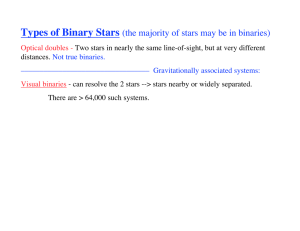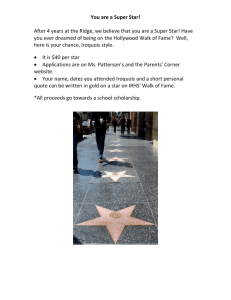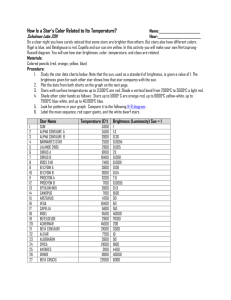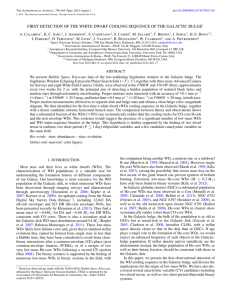Writing The Research Paper - Alt
advertisement
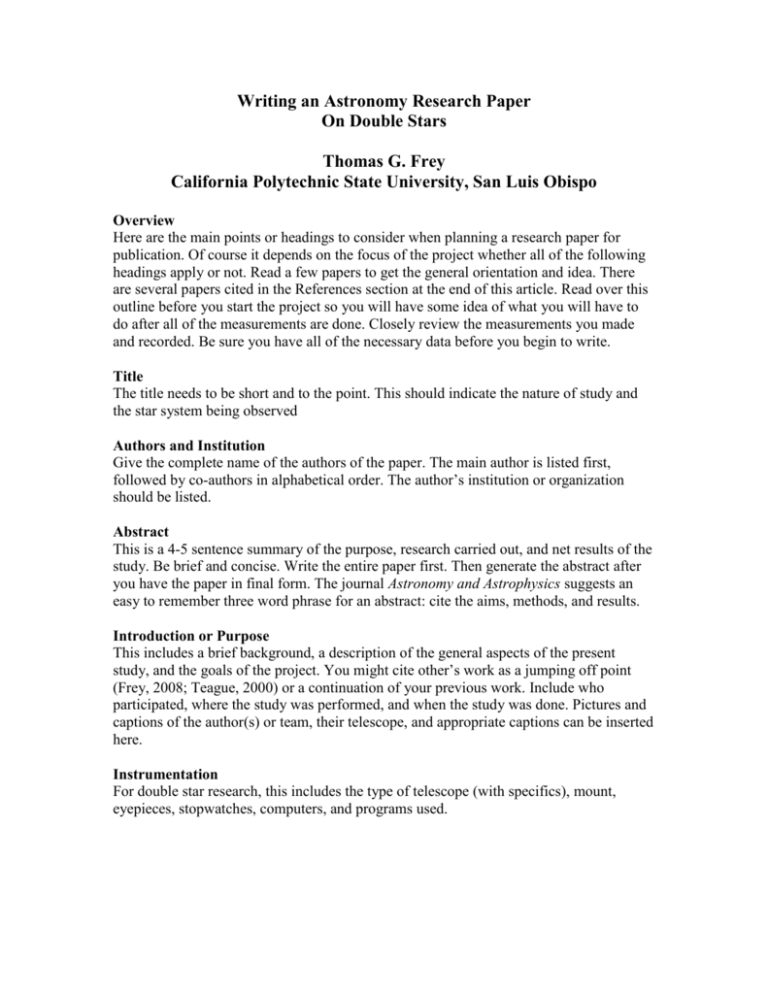
Writing an Astronomy Research Paper On Double Stars Thomas G. Frey California Polytechnic State University, San Luis Obispo Overview Here are the main points or headings to consider when planning a research paper for publication. Of course it depends on the focus of the project whether all of the following headings apply or not. Read a few papers to get the general orientation and idea. There are several papers cited in the References section at the end of this article. Read over this outline before you start the project so you will have some idea of what you will have to do after all of the measurements are done. Closely review the measurements you made and recorded. Be sure you have all of the necessary data before you begin to write. Title The title needs to be short and to the point. This should indicate the nature of study and the star system being observed Authors and Institution Give the complete name of the authors of the paper. The main author is listed first, followed by co-authors in alphabetical order. The author’s institution or organization should be listed. Abstract This is a 4-5 sentence summary of the purpose, research carried out, and net results of the study. Be brief and concise. Write the entire paper first. Then generate the abstract after you have the paper in final form. The journal Astronomy and Astrophysics suggests an easy to remember three word phrase for an abstract: cite the aims, methods, and results. Introduction or Purpose This includes a brief background, a description of the general aspects of the present study, and the goals of the project. You might cite other’s work as a jumping off point (Frey, 2008; Teague, 2000) or a continuation of your previous work. Include who participated, where the study was performed, and when the study was done. Pictures and captions of the author(s) or team, their telescope, and appropriate captions can be inserted here. Instrumentation For double star research, this includes the type of telescope (with specifics), mount, eyepieces, stopwatches, computers, and programs used. Location/Sky Conditions Give site of observation (city or area, longitude and latitude, elevation). Give the general seeing and transparency and the specifics on the nights you observed. Give wind conditions, any light pollution, humidity. Seeing and transparency information can be found on Attilla Danko’s Clear Sky Charts (http://cleardarksky.com). You must then enter the latitude and longitude for your observing site. Calibration For binary star measurements of separation, the linear scale of the astrometric eyepiece must be calibrated to your specific set up. The technique has been thoroughly described in many sources (Frey, 2008; Argyle, 2004). You can also reference your own previous calibration. Known Double Stars Measured Fairly bright binaries of well-known separation and position angle are measured to assure the accuracy and precision of your measuring techniques. Sources of these known binaries are the WDS catalog (Mason, 2009) or a number of texts like Double Stars for Small Telescopes by Sissy Haas. Select binaries that are not too close to the zenith (hard on the neck and difficult to orient the scope) and not too close to the horizon (down in the “soup” where the air is thicker). Choose binaries that have at least a difference of 0.5 magnitude; if magnitudes are too close, it’s hard to distinguish primary from secondary. Avoid binaries that have very dim secondary’s since the laser light of the astrometric eyepiece will often be too bright to see dim stars easily and make separation measurements difficult. If the stars do have very similar magnitudes and are misidentified, the position angles can be readily corrected by adding or subtracting 180 to the recorded value. Stipulate the procedures used to measure the separation and position angles of these known binaries. For instance, if using a Dobsonian mount with a Newtonian scope, did you use the drift method to measure position angle? If using an equatorial mount, did you use an exterior mounted protractor to enhance resolution of the position angle? Tabulate the results. Use proper headings for the tables indicating units of measurement either in the headings or in the sentence prior to the table. Always have a complete title for the table that indicates the data being summarized. Calculate the standard deviation and standard error of the mean for all data recorded. A rule of thumb is to record at least 5-10 separate measurements to reduce random errors and to allow an estimate to be made of the measurement precision. The number of measurements should be entered into your table. The Besselian epoch of observation should be included in the table (see Argyle, p.274). Literature values of the separation and position angle for the binary should be included for comparison to your data along with the epoch for the literature values. For excellent examples of tabulated data, see any of Dave Arnold’s papers in the JDSO. Include the statistics of uncertainty even though many JDSO papers do not. Non-neglected or Neglected Double Stars Measured The over all purpose of binary star measurements is to determine the separation and position angles of binaries, both true binaries and optical binaries, that are relatively under-studied i.e. those with measurement made many years ago or only studied a few times. The best source of these are the WDS (Washington Double Star) catalog available on-line and the Sixth Catalog of Orbits of Visual Binary Stars available on CD from the United States Naval Observatory. The choice of which binaries to select depends on several criteria; 1. It must be visible in the sky and not too close to the horizon or zenith at the time of observation. 2. Chose a binary with a separation capable of being accurately measured with your telescope and eyepiece (neither too close nor too wide). The writer and readers of the article should be able to determine the limits of their system as a function of their equipment and the magnitudes of the system under study. This should make the selection of proposed targets much simpler. 3. Be sure the secondary star is not too faint to be observed with your equipment. 4. In the beginning try one with magnitude differences >0.5. See the previous section on Known Double Stars regarding the tabulation of data. Results, Discussion, and Analysis Briefly restate the purpose of the project. Mention the telescope/equipment used, maybe in one sentence. Discuss the results. Be specific and avoid generalizations. Discuss the standard deviations and standard error of the means of your data. Were your results precise? Did you make enough observations? Did atmospheric conditions (wind, clouds, humidity, turbulence) hamper your observations? You should look up the proper motions of the two stars to see if any results point to the studied pair as being true or optical binaries. This info can often be found on the WDS or the Sky 6 program by Bisque. Conclusions What did you learn from this study? How close did the observed results compare with the literature findings? Does it suggest further studies? Keep your conclusions brief. Acknowledgements Acknowledge those who helped you with the study. Recognize those who refereed your paper. Acknowledge any person used as an outside source. If making observations at a site or observatory other than your own, kindly reference them. The USNO website has a suggested acknowledgement statement if you use the WDS, specifically, “This research has made use of the Washington Double Star Catalog maintained at the U.S. Naval Observatory.” For example, in the case of this document, “I wish to acknowledge R. Kent Clark, Russell Genet, Vera Wallen, and Thomas Smith for their suggestions, additions, and critique of this paper.” References All references made in the paper should be listed here. Be sure to use the proper format. Examples from the JDSO are shown below. Argyle, Robert, Observing and Measuring Visual Double Stars, Springer, London, 2004. Haas, Sissy, Double Stars for Small Telescopes,Sky Publishing, Cambridge, MA, 2006. Teague, Thomas, 2000, Sky and Telescope, July, 112-117. Frey, Thomas G., Spring 2008, Journal of Double Star Observations, 3(2), p. 59-65. Arnold, Dave, Winter 2006, Journal of Double Star Observations, 2(1), p. 13-20. Hipparcos and Tycho Catalogues. July 2009. European Space Agency. http://www.rssd.esa.int/index.php?project=HIPPARCOS. Mason, Brian. The Washington Double Star Catalog. July 2009. Astrometry Department, U.S. Naval Observatory. http://ad.usno.navy.mil/wds/wds.html. Sixth Catalog of Orbits of Visual Binary Stars, ad.usno.navy.mil/wds/orb6.html. TheSkySix, Software Bisque, www.bisque.com/sc/ Astronomy and Astrophysics. www.aanda.org/content/view/136/184/lang,en/ Biographical Data A short 2-3 sentence bio of the author should be included at the end. Include the name, institution, and a brief description of the author’s astronomy background or specific interest. For example, regarding this article: Thomas G. Frey is Professor Emeritus of Chemistry at California Polytechnic State University in San Luis Obispo, CA. He has been an active member of the Central Coast Astronomical Society for over 25 years. He has been making double star measurements for three years.


